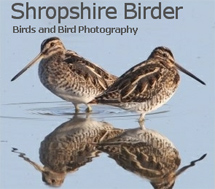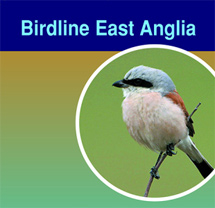Weekly round-up: 04 - 10 Dec 2013
Winter bit hard this week across the UK with an icy blast from the north combining with a low pressure system off the Atlantic to bring snow to northern parts. With swathes of the country impacted by the weather, many coastal reserves closed to the public in the lead-up to the weekend.
Whilst the wintery conditions eased as quickly as they had arrived, they were dramatic while they lasted: with the wind gusting over 140mph in exposed areas of Scotland, and the biggest tidal surge in 60 years down the east coast. Many areas of coastal Lincolnshire, Norfolk and Suffolk suffered extensive inundation with seawater, in some cases extending considerable distances inland. While some effects of this were immediately all too evident, with freshwater fish killed by the sudden influx of salt water, other longer term effects will remain to be seen… It’s likely, for instance, that this extreme weather event is going to have an adverse impact on the breeding success of Bitterns in these areas next year as they will be deprived of the small freshwater fish they rely upon for success.
Photos and videos of the flooding at the end of this week's round-up
Still, it’s an ill wind that blows no good, and seeing just how ferociously the wind came out of the north it wasn’t surprising that it brought some white-winged wanderers with it, some scarce and some downright rare…
Our first proper taste of winter arrived this week, with some properly feisty northerly winds, plummeting temperatures, snowfalls and, as hinted at by last week’s all-too-brief Ivory Gull and Brunnich’s Guillemot, more Arctic rarities.

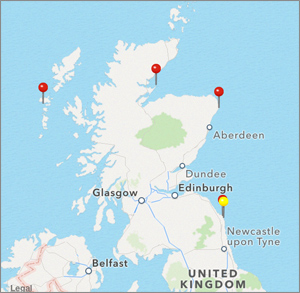
The week kicked off in fine style with the first Ivory Gull being found on 4th at Baleshare on North Uist (Outer Hebrides). No sooner had this beautiful Dalmatian-spotted juvenile been found than the first pictures were winging their way to RBA and hijacking my inaugural Rarity Round-Up… Given what a looker any Ivory Gull is, I can forgive that. Particularly as there were more to follow…
With the northerly wind ratcheting up a couple of gears the following day, and bringing with it the first appreciable snow of the winter at lower levels in Scotland, it must nevertheless have been a pleasant surprise for the finder when the week’s second Ivory Gull was found flying past Tarbat Ness (Highland) in the morning of 5th. Just like the bird seen last week at Seaburn (Co.Durham) neither of these early birds chose to linger.
Matters proceeded to get just a little silly at the weekend when on 7th a gorgeous juvenile Ivory Gull had no sooner been found at Seahouses (Northumberland) than it had been joined by a second bird; and meanwhile the fifth bird of the week was busy being found at Boddam (Aberdeenshire). And (you guessed it) they’d all gone by the following day…
/ivory_gull_2_c.jpg)
A closer look at Steve Duffield’s excellent photo of the Baleshare bird shows it’s stood poised over something long-deceased, and therein possibly lies the moral of the tale – if you want your Ivory Gulls to hang around, find something dead on the beach when the wind’s in a northerly vector. Given the reports of how many dead or moribund Grey Seal pups there are down the east coast in the aftermath of the immense tidal surge last week, we can perhaps hope for more records in the coming days. Every cloud has a silver (or ivory?) lining…
In the past few decades Ivory Gull has been more or less annual in Britain and Ireland, and in some years has turned up in small numbers. To match the recent tally you need to go back to 1980, when six birds were recorded (albeit two of these were found dead). Five in the space of a week is impressive in anybody’s book.
As might be expected with an Arctic vagrant, Scotland has enjoyed the lions share of the records, but a glance at the distribution map shows a pleasing scatter of occurrence right around the coast (though if I lived in Lincolnshire I’d be feeling pretty hard done by right now…).
The last readily accessible bird was 11 years ago in Glamorgan in 2002, and of course the long-staying bird at Aldeburgh in Suffolk proved very popular with birders at the time back in December 1999. This weeks’ birds will give heart to birders further south that another bird might yet arrive shortly much closer to home, and perhaps stay for longer than a few all-too-brief hours.
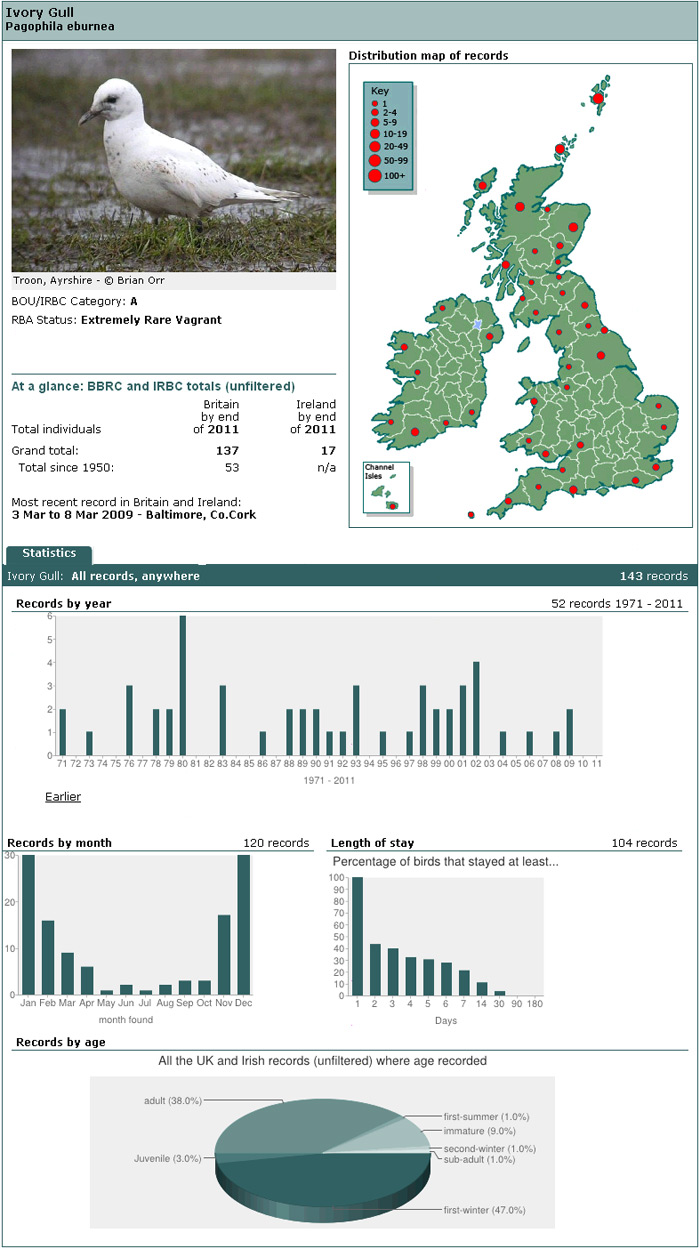
The north of Britain also laid claim to the week’s other big-name rarity arrival, a Pied-billed Grebe at Balranald, North Uist (Outer Hebrides) found on 6th and still present on 9th at least. Had this arrived at the same time as the American Robin on South Uist, and only now come out of the woodwork? Or could this be related to the last record of the species in the Outer Hebrides, on South Uist, and at exactly the same time of year in 2012? Idle speculation aside, this bird represents the third record for Britain and Ireland this year following those in Somerset and Co.Mayo in the spring. The species’ tendency for long stays belies the rarity of it – with only 39 accepted records for Britain (and 10 for Ireland) Pied-billed Grebe remains, numerically at least, a pretty rare bird when all’s said and done; one that may reside on many a life list but on nowhere near so many self-found lists.
/p_b_grebe_jk2013_c.jpg)
/p_b_grebe1_jk2013_c.jpg)
Lancashire’s Baikal Teal continued to find favour at Marshside this week, being seen there until 10th While its detractors in the online ether became fewer in number and quieter as the week wore on and the birds credentials seemed more firmly established, there will doubtless be some amongst its supporters who hope it does the decent thing soon, and moves on. As the Hooded Merganser and Wood Duck drakes of recent years on Shetland would attest, if you’re an attractive duck of a kind commonly found in captivity it doesn’t behove you to stay too long after you’ve been found…
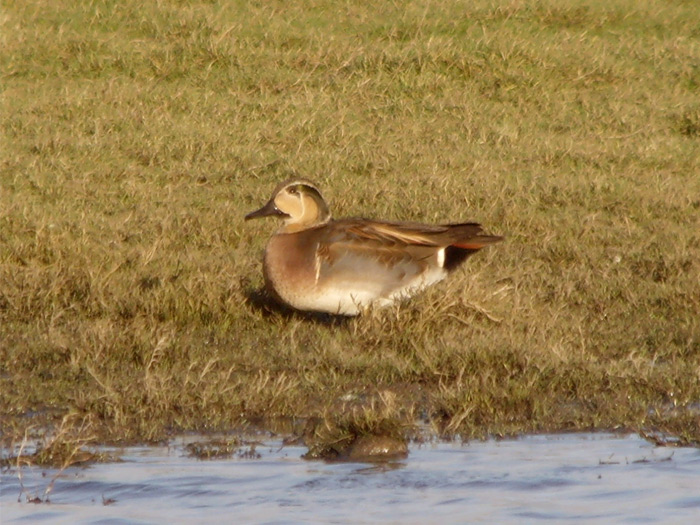
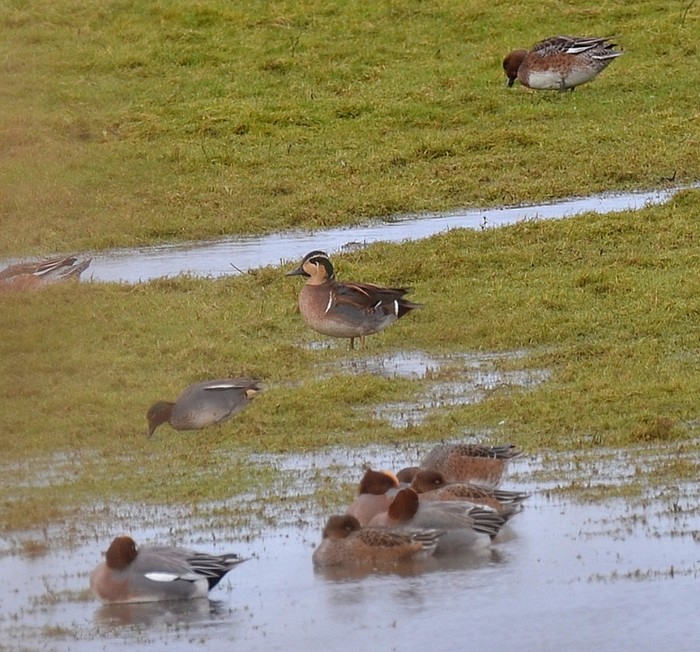
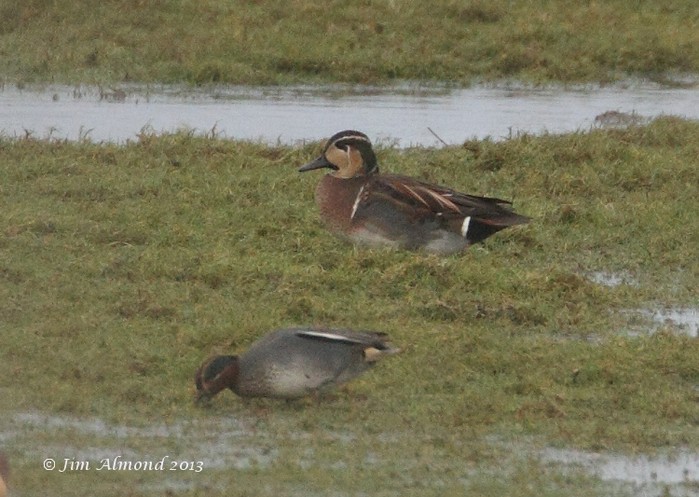
Whilst there was no news this week from Cornwall, it would hardly feel like a proper winter Rarity Round-Up without some mention of a Pacific Diver. Fortunately West Sussex obliged with a probable of the species reported from time to time on 8th-10th from Worthing. True to form with the species, it wasn’t giving itself up easily…
Records of late skuas continued to dwindle to almost nothing, with a Pomarine Skua reported from Suffolk off Landguard on 5th, two birds off Thorpeness on 7th, and another off Thorpeness on 8th.
The south coast and the first half of the week accounted for the only reports of Balearic Shearwaters, these being a single bird past Pendennis Point (Cornwall) on 4th, and two birds past Portland Bill (Dorset) on 5th.
Little Auks were reported mainly from Scotland, with singles off Tiree (Argyll & Bute) on 5th and Rubha Ardvule, South Uist (Outer Hebrides) on 8th. Three birds were recorded from Lossiemouth (Moray) on 5th and Crail (Fife) on 8th. A notable record of a single bird came from much further south off Hengistbury (Dorset) on 4th.
Glossy Ibises continued to find Britain and Ireland very much to their liking even as winter set in, and numbers recorded were up again on the previous week. Singles were reported from Strumpshaw Fen (Norfolk) on 5th, Slimbridge (Gloucestershire) on 6th, Dungeness (Kent) on 5th-10th, Ballycotton (Co.Cork) on 7th, and St.Mary’s (Scilly) on 7th-8th. Four birds seen at Lelant (Cornwall) on 7th had dispersed by the following day with two birds subsequently recorded at Hayle (until 9th) and singles at Marazion, Helston Loe Pool and St.Merryn on 8th. The week concluded with yet another bird noted, this time in Wales at St.Florence (Pembrokeshire) on 10th.
Great White Egrets remained very much in evidence throughout the week; the species feels poised on the cusp of a breakthrough, a bit like Little Egrets did twenty years ago before they became truly ubiquitous. Whilst some birds continued to wander in their chosen areas, it seemed as if numbers remained more or less constant with around 25 birds involved in sightings from East Yorkshire down to the south coast, and as far west as Carmarthen and Powys.
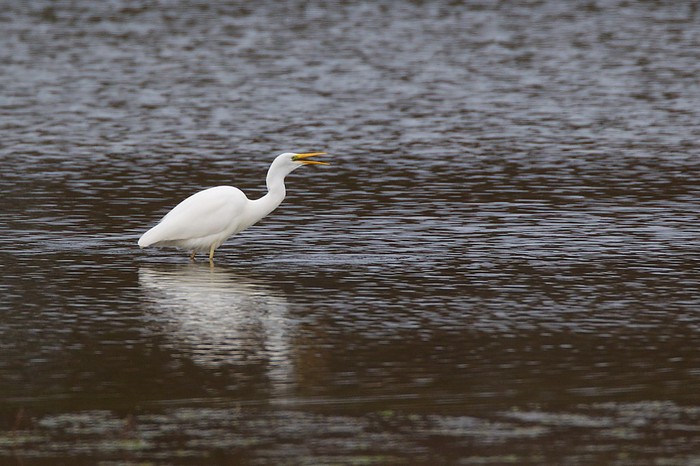
While many records involved single birds, three birds were at Pitsford Reservoir (Northamptonshire) on 6th-7th, and duos were recorded in the Dungeness area (Kent) on 4th, at Burton Mere Wetlands (Cheshire) on 5th, at Marshside and Southport (Lancashire) on 7th; and at Hornsea Mere (East Yorkshire) on 9th. Elsewhere single birds were reported from thirteen counties, including two in Wales.
In Kent, the Cattle Egret remained in the Upstreet area until 8th at least, while the bird first seen roosting at Calvert Lakes (Buckinghamshire) became regular at Steeple Claydon during the day on 7th –9th. A further bird was seen at Cantley (Norfolk) on 7th.
The large Brownsea Island (Dorset) Spoonbill flock had dwindled somewhat by 8th, with a mere eight birds recorded there on that day. The surrounds of Poole Harbour are immense, and sightings from Holes Bay (two birds, on 4th), the Arne (three birds, on 8th), and Shipstal Point (18 birds, on 7th) hint that last week’s impressive consolidated Brownsea flock had not necessarily gone, merely dispersed elsewhere, and sure enough on 9th the Brownsea lagoon flock was back up to at least 20 birds. Outside of Dorset three birds remained on the River Lynher (Cornwall) off Wacker Quay, and individuals were recorded at Cuckmere Haven (East Sussex) on 4th , and at Tetney Marshes (Lincolnshire) on 4th and again on 10th; Shipstal Point Kilnsea (East Yorkshire) and The Cunnigar (Co.Waterford) on 6th (the Irish bird remaining until 9th at least); and Mill Creek (East Sussex) and Castle Espie (Co.Down) on 7th.
A pair of Common Cranes lingered for a few days in Dorset at Cheselbourne from 5th-10th, and another pair remained at Crieff (Perth and Kinross) until 9th.
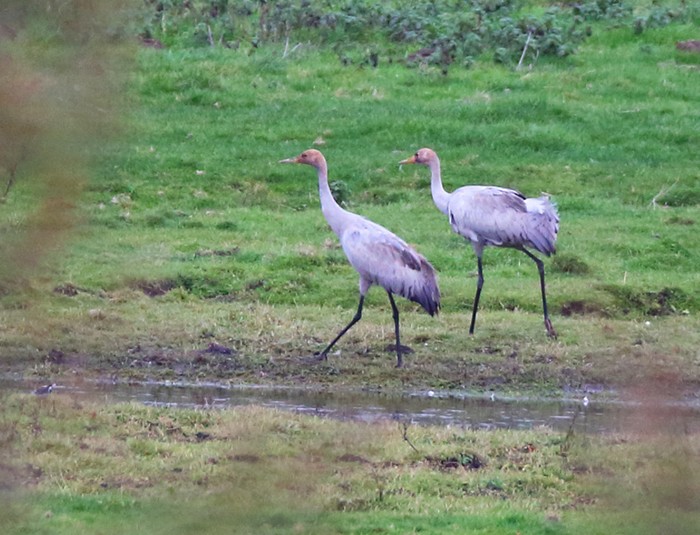
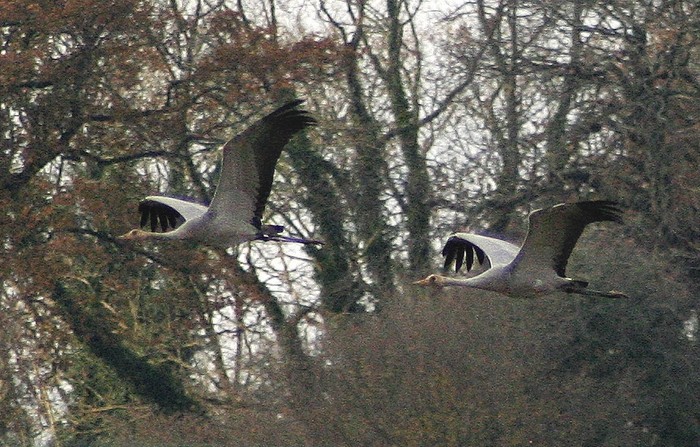
Two Richardson’s Cackling Geese (form hutchinsii) headed the wildfowl bill in Ireland at Killard, Doonbeg (Co.Clare) on 7th, while elsewhere in Co.Clare on the same day a Todd’s Canada Goose (form interior) was noted at Doonbeg.
Black Brant numbers fell away after last week’s largesse; in Dorset, a single bird was recorded on the Fleet on 5th, and both it and its cohort from last week were together again on 7th. Elsewhere, the Roa Island (Cumbria) bird from last week was still present on 5th; in Essex a possible >Black Brant or a hybrid was at St Osyth on 6th; and in Suffolk a probable was reported from Shingle Street on 10th. In Ireland,an adult was at Ardtermon (Co.Sligo) on 6th.
The presumed escape first-winter Ross’s Goose remained in residence at Marshside RSPB (Lancashire) until 10th. The white morph Snow Goose remained at Carrahane Strand (Co. Kerry) to 8th, and in Scotland the two birds remained at Tayinloan (Argyll & Bute) to 6th, while the blue morph stayed at Mains of Ballindarg (Angus) until 4th.
Ten Green-winged Teals were recorded during the week with many lingering on their chosen water bodies. Drakes remained at Loch of Lintrathen (Angus) and Rutland Water (Leicestershire) until 7th; Hickling Broad (Norfolk) until 8th; North Ronaldsay (Orkney) until 10th; and Loch of Kinnordy (Angus) and Caerlaverock (Dumfries) until 10th. Further birds were on the Eden Estuary (Fife) on 5th,Weston-super-mare (Somerset) on 7th and Loch of Strathbeg (Aberdeenshire) on 10th; while in Ireland at least two were reported from Tacumshin (Co.Wexford) on 6th, with one still on 7th. Back on North Ronaldsay was a Blue-winged Teal found on 5th, and still present on 8th.
The female Lesser Scaup continued to find its new quarters at Loch an’t-Saile on South Uist (Outer Hebrides) to its liking until 7th . The first-winter female was still at Murlach, Ballyconneely (Co. Galway) on 5th, and the drake remained in Cardiff Bay (Glamorgan) until 7th.
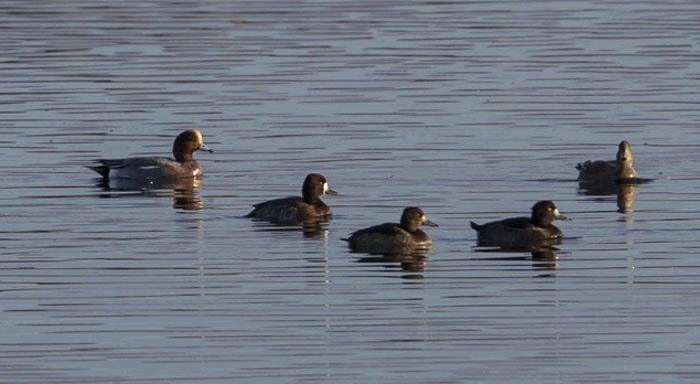
Ireland retained its monopoly on Ring-necked Ducks this week with birds recorded at Lough Leane (Co.Kerry) on 5th – 8th and at Lough Doo, Achill Island (Co.Mayo) on 8th. Eyes peeled on Achill Island that day also turned up the long-staying drake Black Duck at Sruhill Loch; accompanied by a hybrid, showing that he’s been busy in the interim…
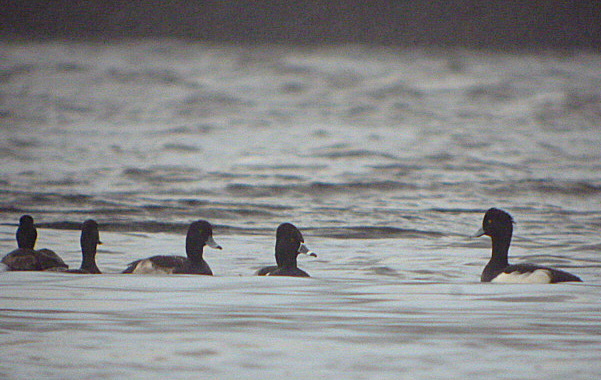
Ireland also accounted for the week’s two American Wigeons sightings with drakes remaining at Tullaghan (Co. Leitrim) to 8th and Lough Neagh (Co.Armagh) until 7th.
In Scotland, a new drake King Eider was found off the golf course at Nairn (Moray) on 8th.
Two drake Surf Scoters were reported off Winterton Dunes (Norfolk) on 4th; elsewhere, in Wales the two birds remained at Morfa Bychan (Gwynedd) until 6th and the two drakes remained at Llandulas (Conwy) until 8th, and in Dorset the juvenile was still to be found in Brand’s Bay, Poole Harbour until 7th. Finally, a drake last reported back in late November was again at Largo Bay (Fife) on 10th.
The adult American Golden Plover remained in the fields near Sennen (Cornwall) until 5th but was not reported subsequently; meanwhile Hampshire’s Lesser Yellowlegs remained at Lepe CP throughout the week.
The wintering adult Bonaparte’s Gull in south Devon was seen off and on in the Dawlish Warren area for much of the week, reported until 8th at least.
The second-winter Kumlien’s Gull remained at Barmston (East Yorkshire) until 7th, and what was presumably the same bird was recorded at Hornsea Mere on 4th.
Predictably, with the strong northerly airflow across the country came a surge in records of both Glaucous and Iceland Gulls, with a noticeable uplift on the 6th coinciding with the favourable weather.
Glaucous Gull numbers rose sharply with at least 30 birds recorded from all corners of the region. Reports peaked sharply on 6th when 10 new birds were noted, including one from as far south as Kent, seen in the English Channel just southeast of Dover. Records came from 22 counties, and showed some northerly bias, as might be expected; but the gull roosts of central England held their own respectably too. Birds were noted in the west in Ireland in Co.Clare, Co.Mayo and Co.Waterford and, by 8th, a bird had filtered as far southwest as Green Island (Scilly).
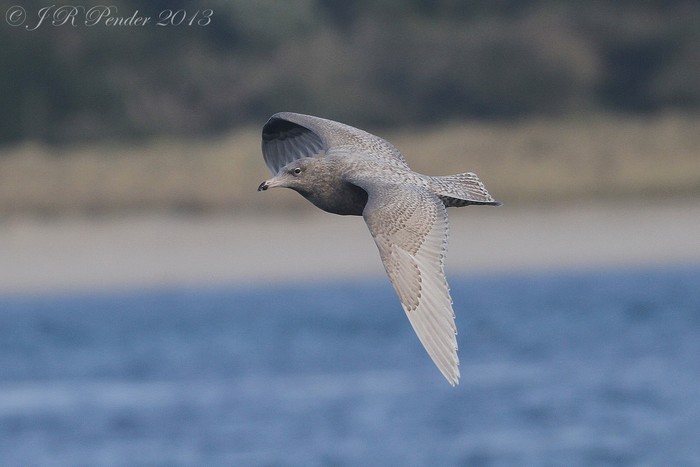
Meanwhile, Iceland Gull numbers had also lifted with around 40 birds recorded throughout the week with lingering birds in the Midlands augmented by a wave of new arrivals, again kicking off with a vengeance from 6th when, with pleasing symmetry to Glaucous Gulls, 10 new birds were noted. Records came from some 20 counties including records from the southeast (a bird at Beddington sewage farm (London) on 9th) and the southwest (at Hannafore Point (Cornwall) on 8th).
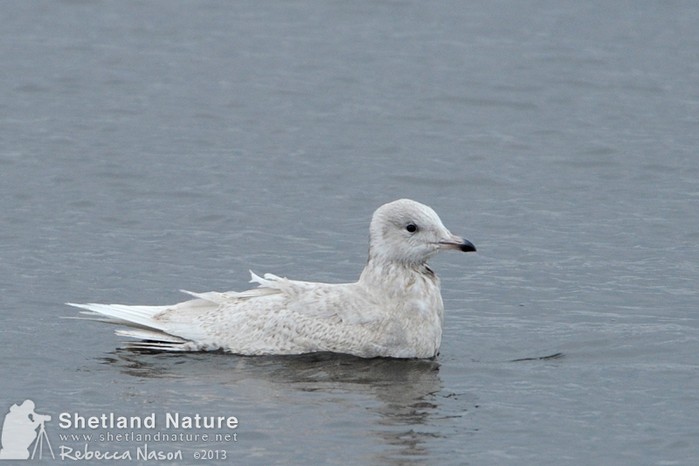
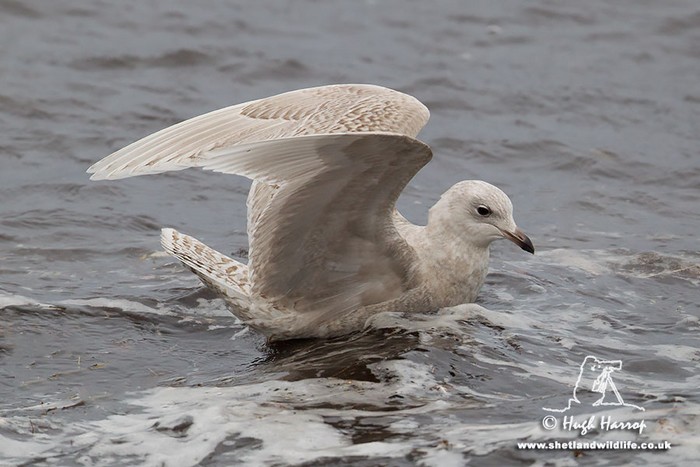
Fifteen Ring-billed Gulls were recorded this week, with some new birds cropping up amongst the usual suspects. Birds from last week remained at Dingwall (Highland) until 6th, and Walpole Park, Gosport (Hampshire) until 8th; whilst in Ireland the adult and second-winter remained at Tralee Bay Wetlands (Co.Kerry) until 10th, and the adult and first-winter at Nimmo’s Pier (Co.Galway) on 4th, with just the first-winter there by 7th. Elsewhere in Ireland the adult remained at Carrickfergus (Co.Antrim) until 4th. Further single birds were reported in Ireland at Tramore (Co.Waterford) between 5th and 9th; at Castletown Berehaven (Co.Cork) and Lurgangreen (Co.Louth) both on 8th; and Ross Beach (Co.Galway) on 9th-10th. Scotland laid claim to an adult at Doonfoot (Ayrshire) on 7th, with a first-winter reported from Baleshare, North Uist (Outer Hebrides) on the same day. Dorset scored with two birds during the week, a first-winter reported from Swineham gravel pits on 8th, and then an adult at Radipole on 10th; the Swineham bird might account for the bird reported earlier in the week in the county at Holes Bay in Poole Harbour on 5th.
A Sabine’s Gull was discovered at West Angle Bay (Pembrokeshire) in the morning of 10th. More troublesome larid identification challenges came in the form of two possible Azorean Yellow-legged Gull individuals recorded at Strathclyde Loch (Clyde) on 4th-7th and at Baltimore (Co.Cork) on 5th.
The Forster’s Tern remained at Nimmo’s Pier (Co.Galway) this week, being reported on 4th at least.
Some unseasonal variety was added to the usual winter suspects amongst the rarer raptors this week with a Black Kite in Kent first seen at Samphire Hoe on 4th, and subsequently a little further up the coast near Sandwich on 6th. In Ireland, the laurels went to a Gyr Falcon at Clahane Strand (Co.Clare) on 4th.
The Orford Ness (Suffolk) Rough-legged Buzzard was still present until 8th at least. Elsewhere, another bird was recorded at Highcliffe Nab (Cleveland) on 4th, while one lingered at Foulness (Essex) from 7th-10th. In Norfolk, two birds could be seen hunting from the Waveney Forest mound from 7th-9th.
Could this be the first time ever that a Melodious Warbler has headed the passerines news section of the Rarity Round-Up? Granted neither the bird in Dorset this week from 6th-9th nor a Hoopoe at Abergele (Conwy) from 8th-10th are proper rarities in their own right, but occurring in the second week of December both deserve some attention paid to them. Heaven knows what the finder of the Melodious must have first thought when they clapped eyes on this deeply unseasonal bird in the famous ‘Bluetail Valley’! For a while it felt more like August than the run-up to Christmas.
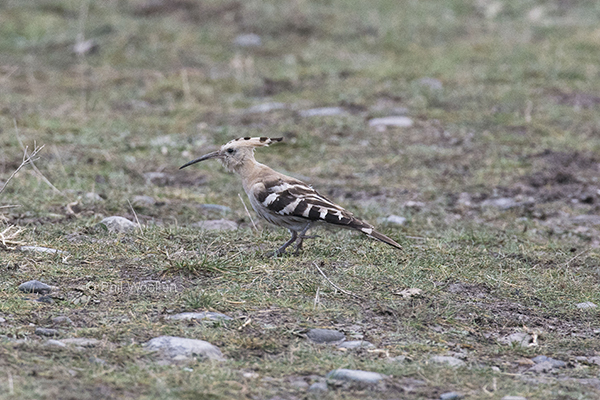
Elsewhere last week’s two Hume’s Yellow-browed Warblers proved to be the heralds of the autumn’s third confirmed record of the species, with one at an as-yet undisclosed site in Northamptonshire from 6th. Initially identified as a Yellow-browed Warbler, this is the first record for the county, and would have proved deservedly popular over the course of the weekend had access to the site been possible at the time. As it was, local birders had to wait patiently until 11th before getting a bite at this particular cherry.
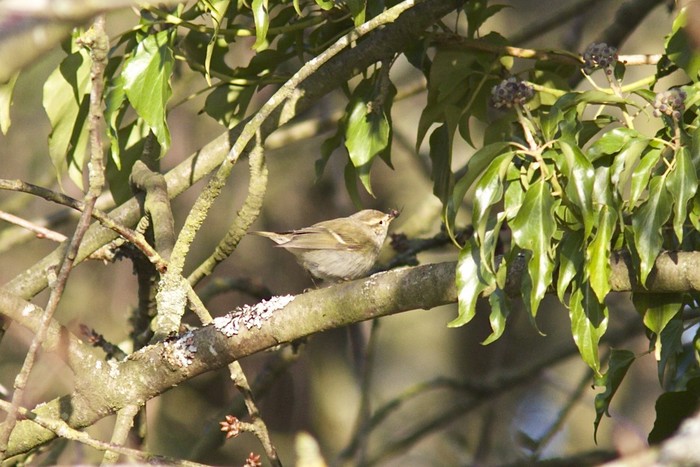
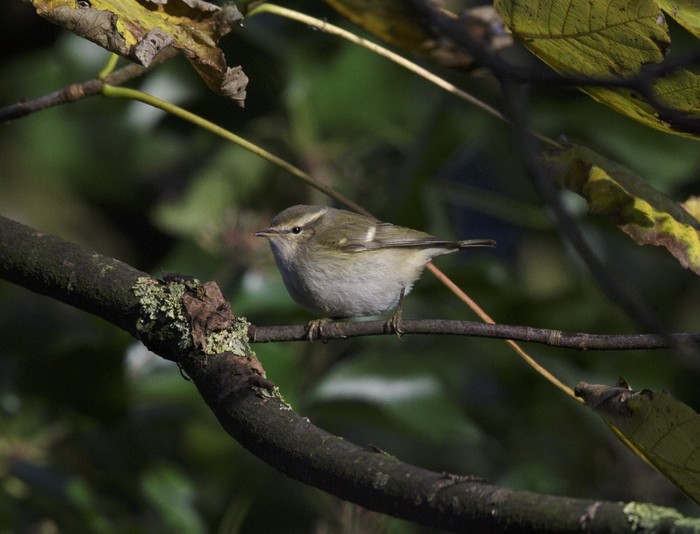
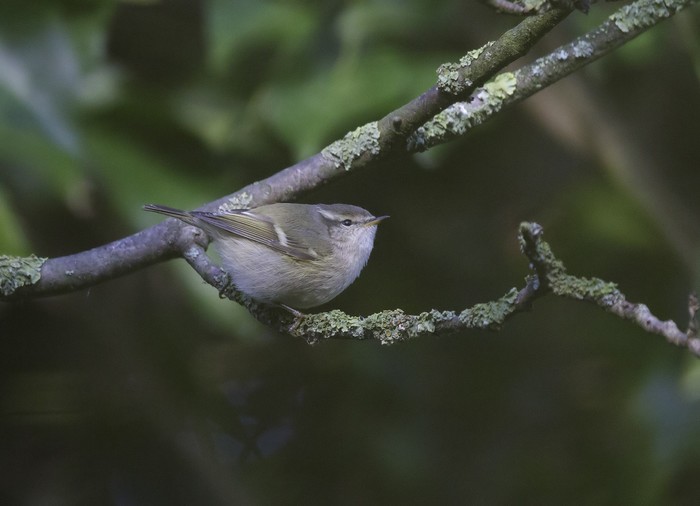
Yellow-browed Warblers continued to be seen in the southwest at Clennon Valley Lakes (Devon), Winspit Valley (Dorset) and on St Mary’s (Scilly) throughout the week, with the two birds on the latter rising to three confirmed birds by 8th. Other single bird records came from Hengistbury Head (Dorset) on 7th, Gunwalloe (Cornwall) on 8th, Studland (Dorset) on 9th, and Ringstead Bay (Dorset) on 10th. (Scilly was getting firmly into the habit of increasing existing numbers of scarce birds this week, with last weeks single Serin becoming two birds, at Rocky Hill, St Mary’s on 7th).
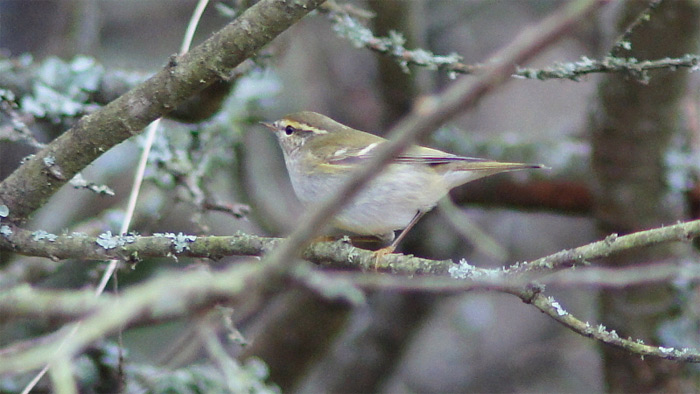
Reports of Great Grey Shrikes more or less halved on the previous week, with around a dozen records from England and Wales. Birds remained on station in Hampshire, Gloucestershire, West Sussex, Surrey, Cambridgeshire, Nottinghamshire, Staffordshire and Powys. New birds were found at Hambridge (Somerset) and Bassingham (Lincolnshire) on 7th, and remained through the weekend into the new week. In Dorset the Morden Bog bird was joined by a second individual on 10th.
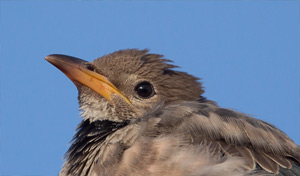
(© Carl Chapman - Wildlife Tours and Education)
The first-winter Rose-coloured Starling at Caister-on-sea (Norfolk) remained faithful all week, and continued to be reported on a more or less daily basis.
Reports of Waxwings perked up somewhat this week with birds reported from twelve counties from Scotland down the east coast as far south as Norfolk, and further inland at Naphill (Buckinghamshire). Whilst most involved small parties of under ten birds (and in several cases just one or two individuals) more notable flocks were around 50 birds in Elgin (Moray) on 8th, 21 birds at Harwood Dale (North Yorkshire) on 6th-10th, and 15 at Eskbank (Lothian) on 10th. Whilst far from a classic Waxwing year, there remains hope that one or two of these charismatic birds may yet be coming to a supermarket car park near you.
In the now regular weekly Loxia news slot, there were new arrivals to report, in particular of Parrot Crossbills. Whilst numbers at Holt (Norfolk) dwindled from 12 at the start of the week to a mere nine by the week’s end, new birds turned up elsewhere in Derbyshire, Nottinghamshire, and Suffolk. Two birds in Goyt Valley (Derbyshire) on 6th were closely followed by the discovery of two larger flocks on 8th, numbering 13 birds in Nottinghamshire at Budby Common (rising to 14 birds by 10th) and 10 birds at Mayday Farm (Suffolk). With the female in Kent still regular at Hemsted Forest, it’s clear that checking your local Common Crossbill flock may pay dividends.
And if the prospect of finding Parrot Crossbills weren’t enough, there’s still plenty of evidence to suggest that there may be more Two-barred Crossbills out there too… Single birds remained from the previous week at Hemstead Forest (Kent), Leith Hill Wood (Surrey) and Lynford Arboretum (Norfolk), though seeing the latter bird was somewhat complicated by the presence of a wing-barred Common Crossbill in the area. Numbers of Two-barred Crossbill reported from Wyre Forest fluctuated between one (on 8th) and a high of four on 7th; meanwhile at Broomhead Reservoir (South Yorkshire) numbers also varied with between five (on 4th) and eight on 8th; and in the Forest of Dean in Gloucestershire the lingering birds at Serridge Ridge varied from three (on 5th) to 17 on 10th. Given all members of the Loxia tribe’s ability to melt away unseen amongst conifers, it’s unsurprising that numbers in the ‘known’ flocks have ebbed and flowed over the past weeks. The smart money must be on there being more Parrot and Two-barred Crossbills waiting to be found in sometimes overlooked or underwatched conifer habitat…
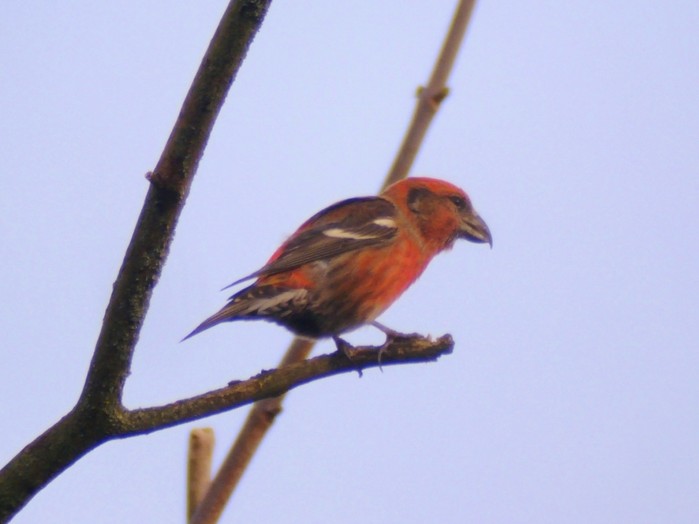
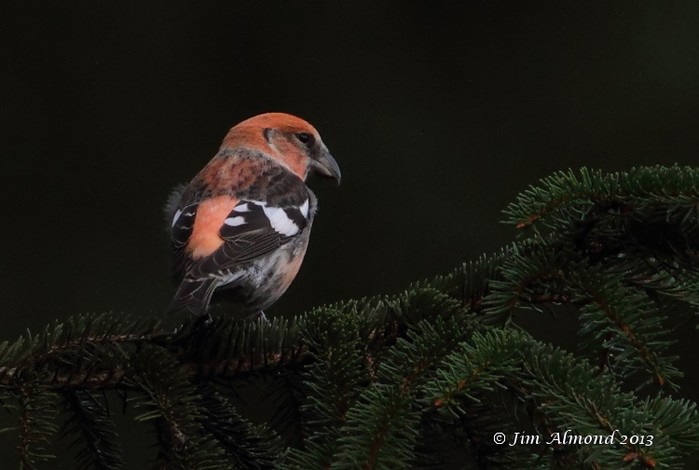
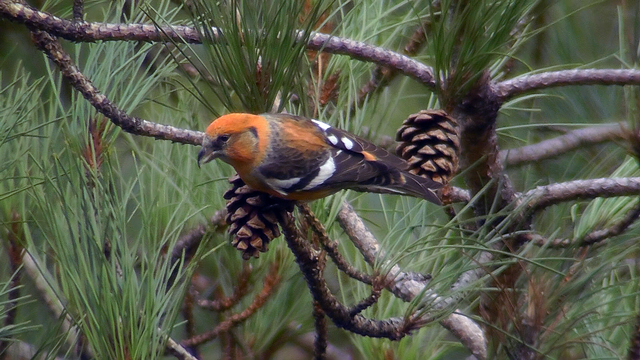
With Christmas almost upon us, it’s time now to get a last-minute request in the mail to Santa for one last top-drawer rarity as the year edges closer to an end. The coming week offers some potential for the rarity-hunter with an eye to the past to make an educated guess as to what might come winging its way towards us...
A rare gull or two is certainly statistically likely, and history shows that the coming week is a good one for Ivory Gulls. But, y’know, we’ve kinda done that already this last week, so…
…with the lingering Hawk Owl still being reported just across the water at Zwolle in Holland (and now a Pygmy Owl in Holland at Lettele), and past records of both Snowy Owl and (whisper it) Tengmalm’s Owl in the UK in the coming week, perhaps I am going to ask Santa for a rare owl this Christmas.
(I could wait until Christmas itself, or have my present early in the coming week. I’m not fussy like that. And nor, I suspect, would many other people be either...
Jon Dunn
(who has been a very good boy this year)
11 December 2013


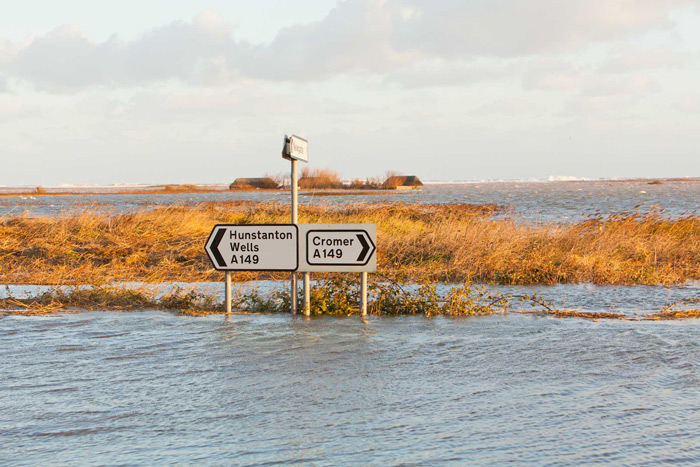
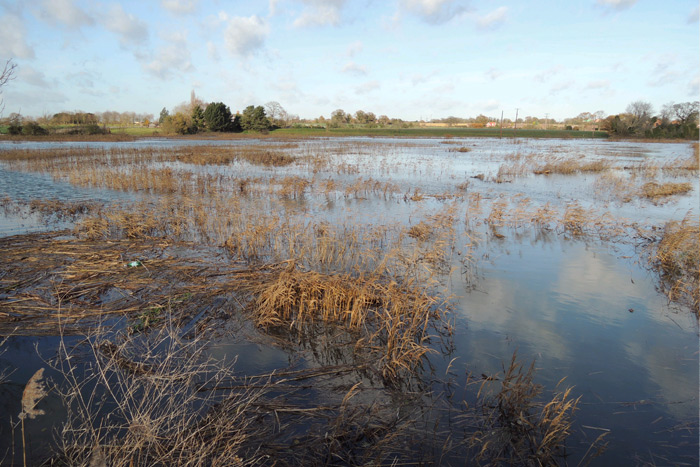
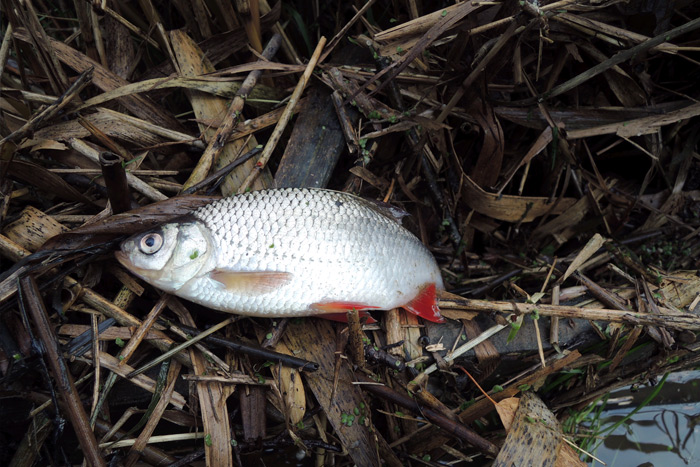
Many thanks to this weeks conributors for their photos and videos.













